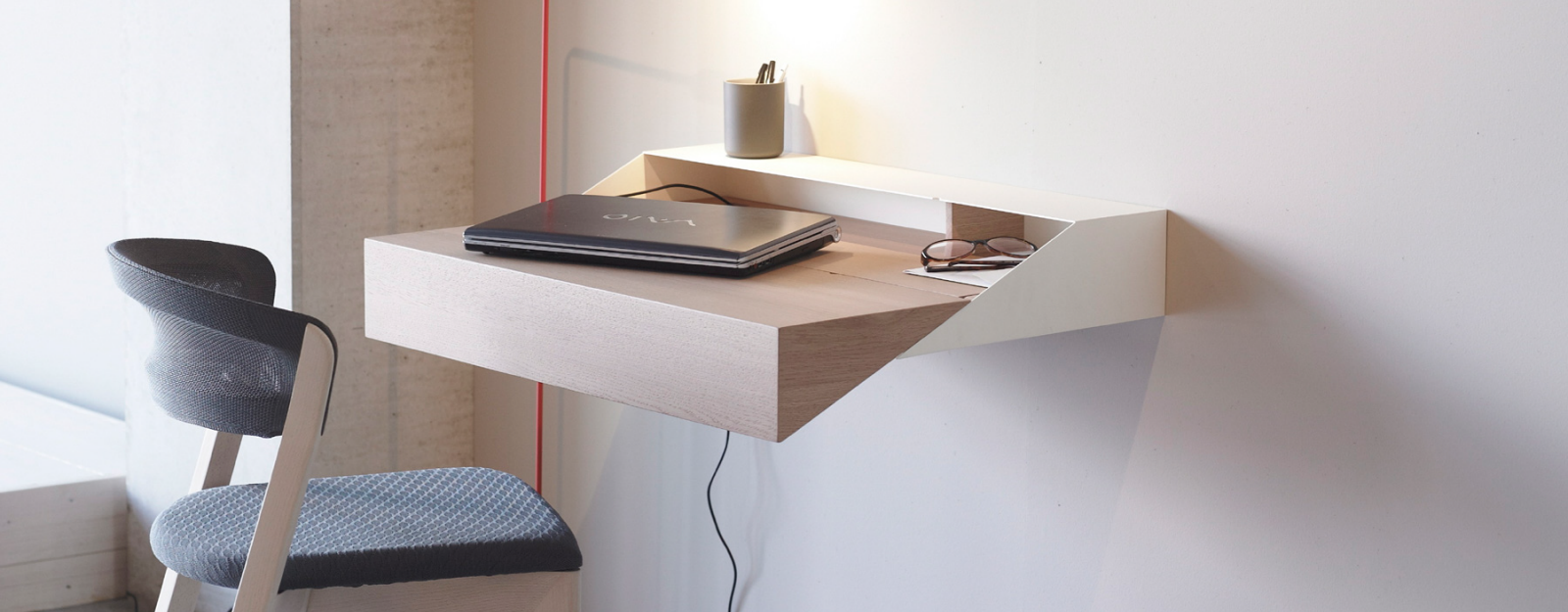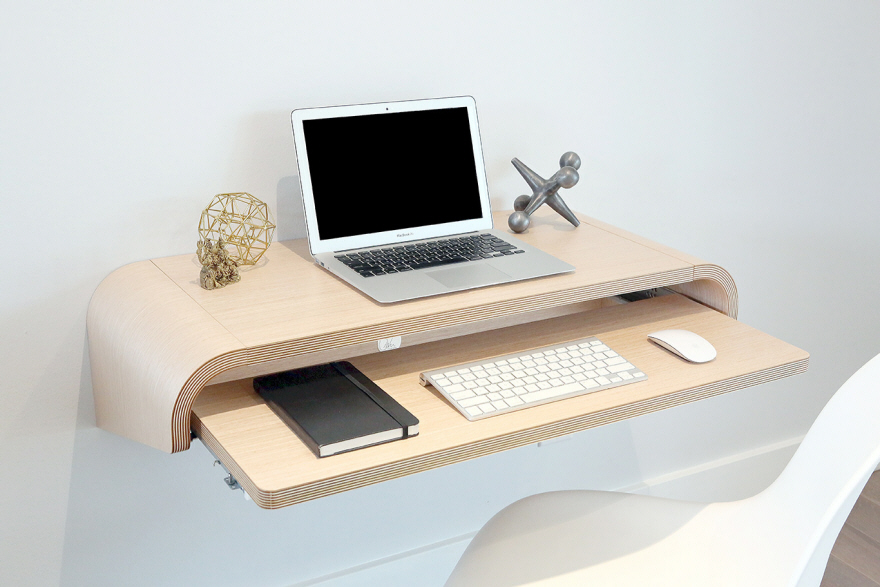
Get to Work at These 9 Wall-Mounted Desks
Making the most of small spaces
I'm not generally a fan of wall-mounted desks because it's often nicer to position as desk so the end user is not looking at the wall. But in some small spaces a wall-mounted desk is the best alternative. We've mentioned the Ledge from Urbancase before, but there are many more designs worth a look.
 Enter a caption (optional)
Enter a caption (optional)The Deskbox from Arco, designed by Raw Edges, looks like a simple shelf when not in use, but it opens up to create workspace that would be fine for a laptop user. There's an outlet in the left rear for running a cord. And there's even a tiny bit of storage space.
 Enter a caption (optional)
Enter a caption (optional)The LAXseries wall-mounted desk from MASHstudios provides a lot of cubbies for easy storage (as long as small items don't get shoved to the back).
 Enter a caption (optional)
Enter a caption (optional)This desk can also accommodate a desktop computer, not just a laptop. It's 58 inches long, which may be too big for some end users—but those who have the space will appreciate the generous workspace.
 Enter a caption (optional)
Enter a caption (optional)As someone who is always bugging her clients about ergonomics, I'm delighted to see the Minimal Desk from Orange22 Modern, which has a tray that can be used for a keyboard and mouse.
 Enter a caption (optional)
Enter a caption (optional)The desk comes in two sizes; the large is good for those with a desktop computer, while the smaller one would be fine for laptop users.
 Enter a caption (optional)
Enter a caption (optional)As you might expect, the desk has a wire management slot.
 Enter a caption (optional)
Enter a caption (optional)The Sequel wall desk from BDI, designed by Matthew Weatherly, has some nifty hidden features. (Purchasers note it's easy to assemble, too.)
 Enter a caption (optional)
Enter a caption (optional)First, there's the hidden keyboard tray (or storage drawer).
 Enter a caption (optional)
Enter a caption (optional)And then there's all the wire management that can go on behind the lower panel. This will be especially nice for end users installing the desk in a public area of the house, those concerned about children or pets getting the the cords, or those who just hate looking at dangling cords.
 Enter a caption (optional)
Enter a caption (optional)Some end users will prefer a secretary-style desk which closes up (and extends minimally into the room) when not in use. The NUBO from Ligne Roset, designed by GamFratesi, is one such wall-mounted desk.
 Enter a caption (optional)
Enter a caption (optional)The NUBO has a cable pass-through slot and a retaining bar for documents. (End users who would like to store things like pens are out of luck.) There's a magnetic closure at the top.
 Enter a caption (optional)
Enter a caption (optional)Michael Hilgers designed two wall-mounted desks for Müller Möbelwerkstätten. The Flatframe is one of those; someone walking by might wonder why there's a cord dangling from the picture frame, and why there's a chair in front of it. (The Flatframe is also available with a plain white exterior, allowing it to blend into a white wall, if the shades of white match. A blackboard front is yet another alternative.)
 Enter a caption (optional)
Enter a caption (optional)But open up the Flatframe and there's a thoughtfully designed desk for laptop users, with storage for pens, a tablet and a smartphone; the rear panel is a magnetic board.
 Enter a caption (optional)
Enter a caption (optional)The Flatframe was obviously designed for a European audience; there are multiple outlets for Euro plugs. End users in many parts of the world would need converters if they wanted to use this very nice feature.
 Enter a caption (optional)
Enter a caption (optional)The Flatbox has three organizational pieces that end users can arrange as they like on the rear panel. It would be nice if additional pieces could be purchased, but this doesn't seem to be an option.
 Enter a caption (optional)
Enter a caption (optional)The Flatbox also has a florescent light and one outlet for charging. So this item, like the Flatframe, will need to be located near an outlet to take full advantage of its features.
 Enter a caption (optional)
Enter a caption (optional)One of the organizational pieces will work fine as a stand for at least some iPads. Designing for end users who are more tablet-focused than laptop-focused is something that may become increasingly important in the future.
 Enter a caption (optional)
Enter a caption (optional)ErgotronHome has two models of wall desk: the Hub24 and the Hub27. Both of them have organizing trays for the rear panel that end users can arrange as they like. There's a place for end users to put their own power strips, but none are provided with the desk.
 Enter a caption (optional)
Enter a caption (optional)Both models also have a glass worktop surface that can also serve as a dry-erase board.
The Hub27's added features include a key lock and 9 inches of desktop height adjustment. When the surface is raised, it might interfere with reaching the rear organizers, but it can easily be lowered again if need be.
One drawback that purchasers noted: The Hub27 is a heavy item, at 20+ pounds, and there's no way to get both of the mounting holes to align with a stud.
 Enter a caption (optional)
Enter a caption (optional)The Podpad from Ruphus is a design with lots of storage behind those doors. It's mounted with a French cleat, which is supplied.
However, the company had to stop offering the version with the speaker compartment on the bottom when the speakers it was built for got redesigned. (The entire product line is sold out now.) That's a reminder about the challenges involved in designing around a specific third-party product.
-
o1Favorite This
-
Q1Comment
K
{Welcome
Create a Core77 Account
Already have an account? Sign In
By creating a Core77 account you confirm that you accept the Terms of Use
K
Reset Password
Please enter your email and we will send an email to reset your password.




Comments
you missed the www.modeller.ca wall desk!